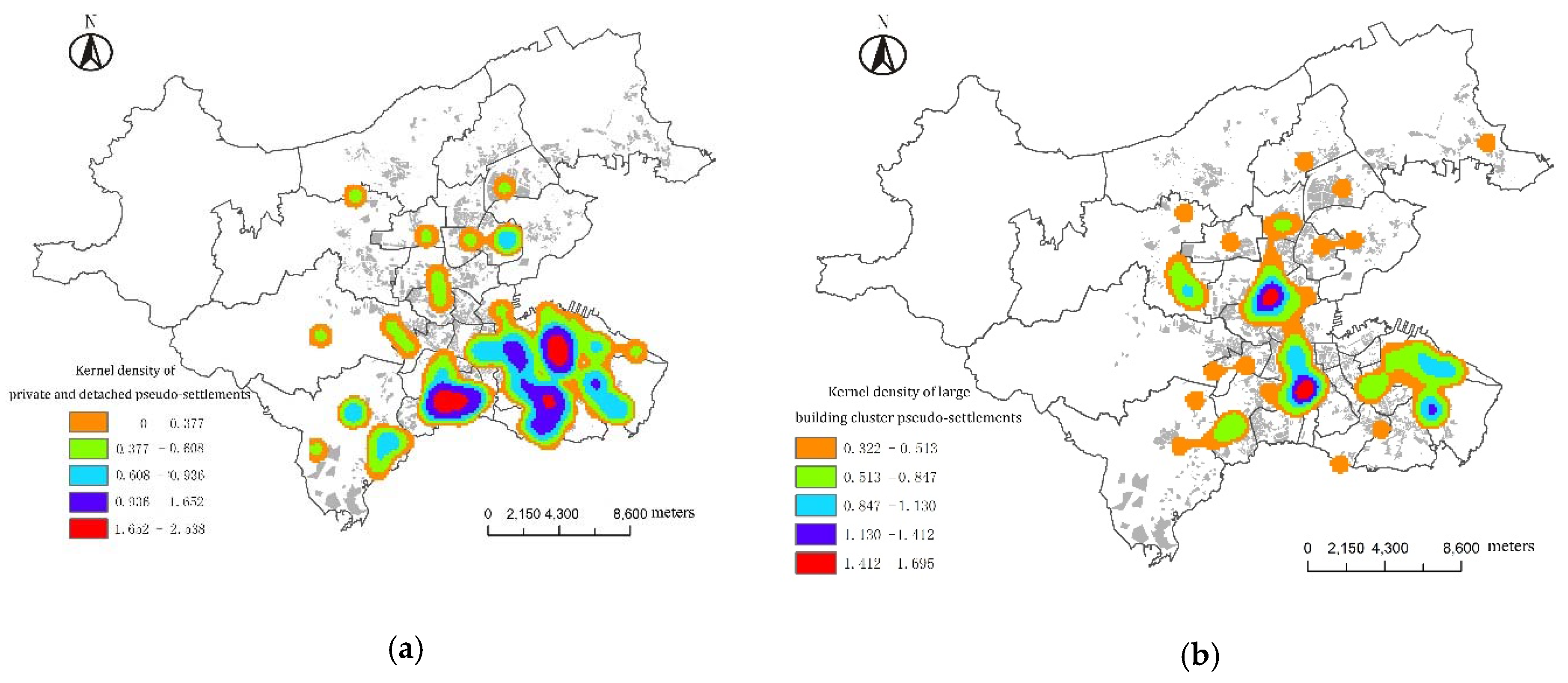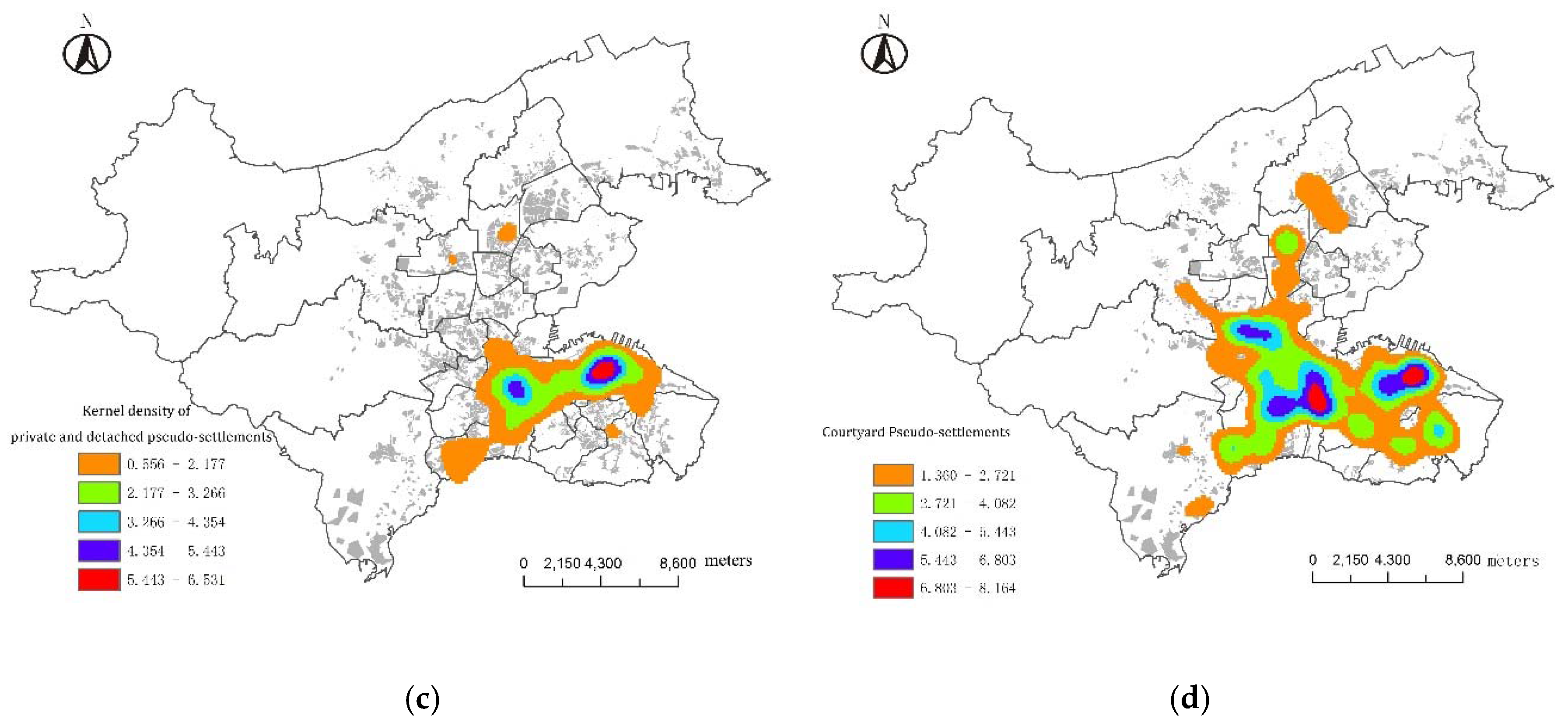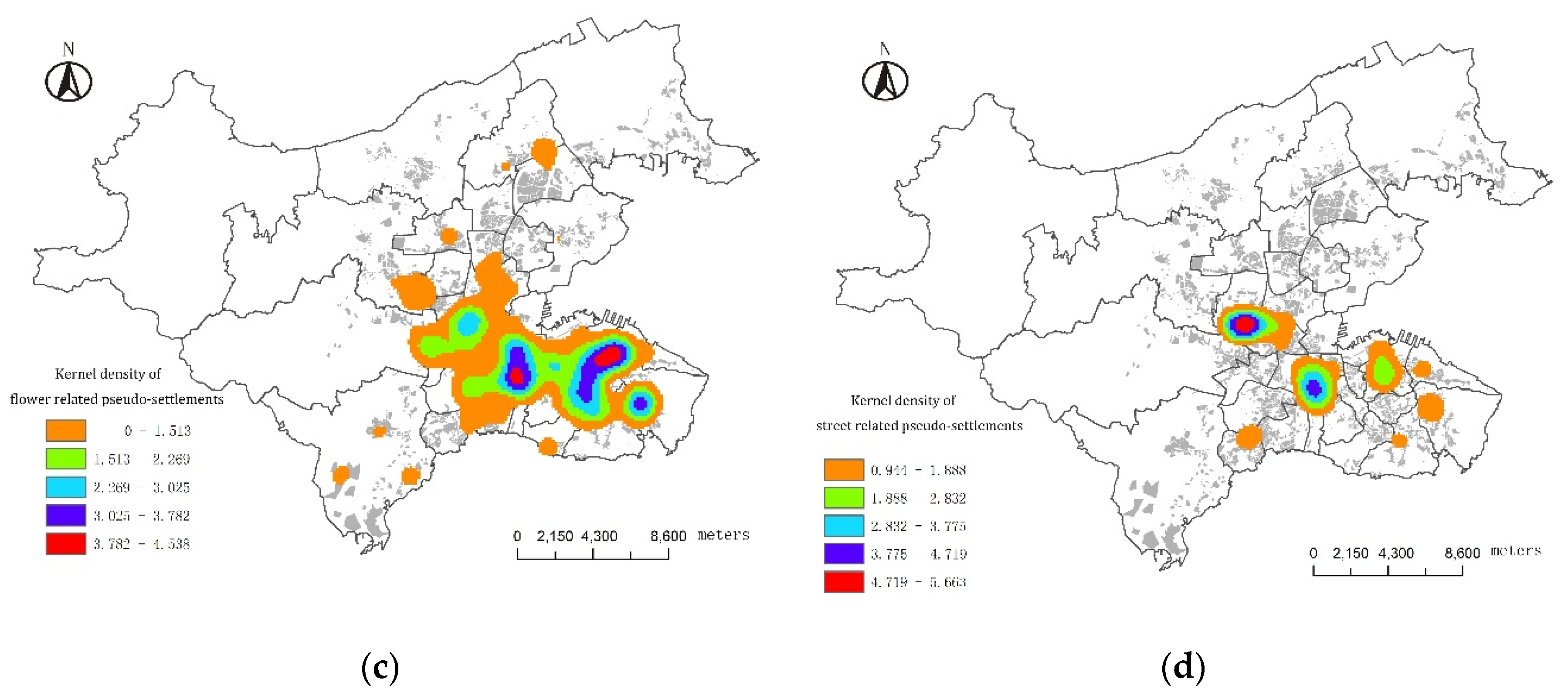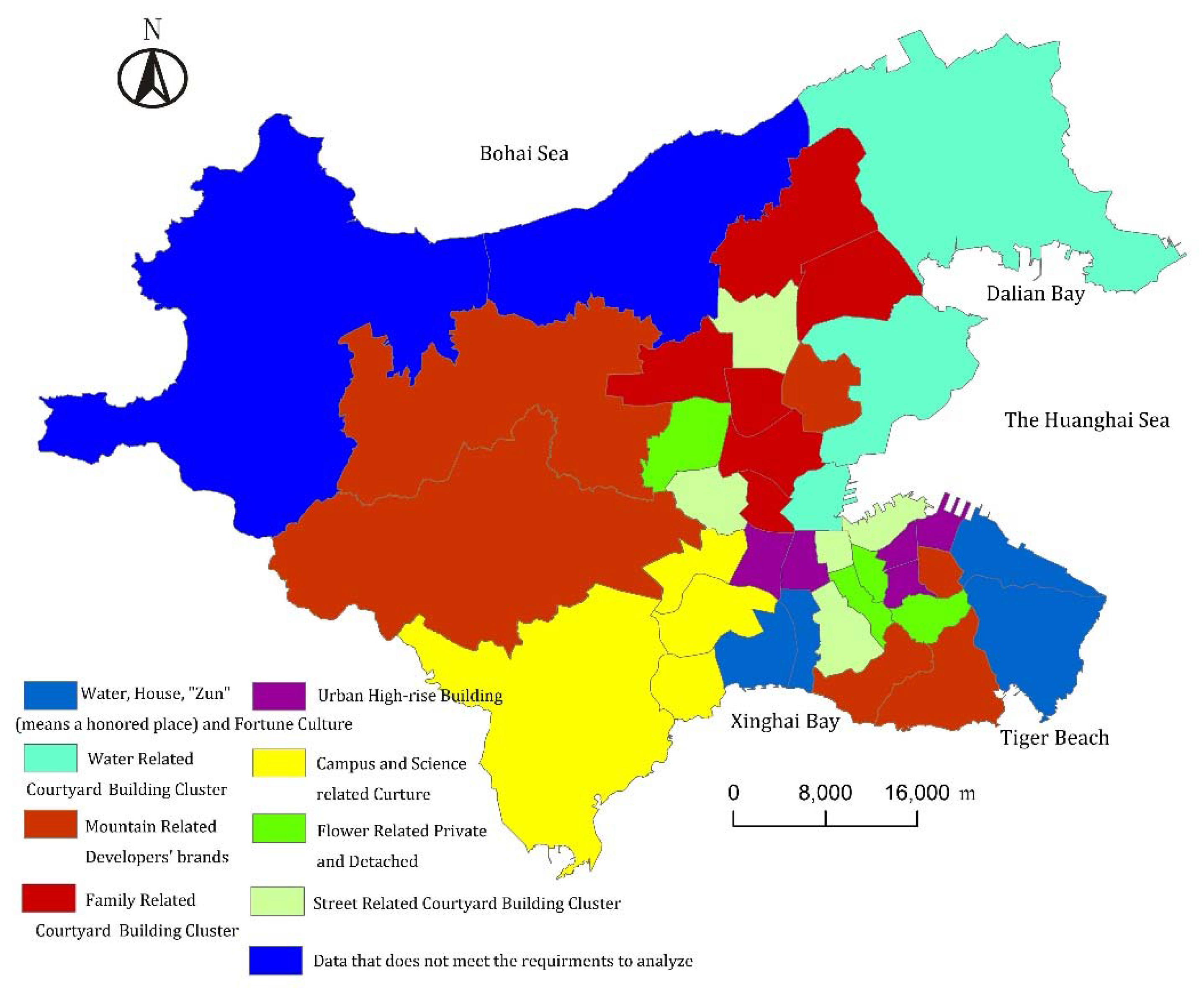Basic Characteristics and Spatial Patterns of Pseudo-Settlements—Taking Dalian as An Example
Abstract
:1. Introduction
| Real-Life Settlements | Places People Work, Live, Rest and Socialize in Real-Life |
|---|---|
| Pseudo-Settlements | Places that are selectively recorded and re-presented after the mass media chose and re-structured the residence information. |
| Imagined Settlements | Places that people imagine after rational thinking and perceptual cognizance based on the information they got from real-life settlements and pseudo-settlements. |
| Spreaders | People who collect, make and spread information. It is also possible that spreaders use the mass media to direct the choice of audiences for certain purposes. |
| Pseudo-Display | All the information spreaders selectively choose, code and spread. |
| Audience | People who receive the information from mass media. They are one of the reasons spreaders spread information and the object pseudo-settlements affects. |
2. Study Object and Index System
2.1. Study Object
2.2. Study Area and Data

| Data Classification | Data Source | Website |
|---|---|---|
| Residential Quarter Spatial Data | Land Resources Development Research Center of Dalian * | http://www.gtfwj.dl.gov.cn/ |
| Residential Quarter Names | Baidu Maps | http://map.baidu.com/ |
| Soso Maps | http://map.qq.com/ | |
| Dalian Real Estate | http://www.lowlo.cn/ | |
| SouFun | http://dl.fang.com/ | |
| Bus Stop Names | http://www.dalianbus.com/sngj/index_gjxl.asp | |
| Peninsula Morning News | http://epaper.hilizi.com/ |
2.3. Methods of Extracting and Distinguishing Characteristics of the Pseudo-Settlements in Dalian
2.4. Visualization Methods for Dalian Urban Pseudo-Settlement
3. Results
3.1. Architectural Features of Pseudo-Settlements
| Pseudo Type | Characteristics of Different Categories | Sample Quantity/Ratio | Example |
|---|---|---|---|
| Architectural Characteristics | Private and Detached PSs | 77/9.553% | Tiger Beach Villa, Golden Bauhinla Mansion, Fuji Manor, Zhongnanhai Palace |
| High-rise PSs | 97 /12.034% | Wanda Mansion, Plat Villa, Dalian Greenland Centter, New Tiandi Mall | |
| Large Building Cluster PSs | 89 /11.042% | Peace Plaza, Top of the City, Wanghai Community, Fujia Mingdu | |
| Courtyard Building Cluster PSs | 387/48.015% | China Yard, Buttonwood Garden, | |
| Region Characteristics | Water-related PSs | 169/20.968% | Sea of Love Garden, Seaview Imperial Garden, Haitian Yingzhou, Jinguang Coast |
| Mountain-related PSs | 95/11.787% | Beauty Peak East Park, Celestial Heights, Mountain Living Note, Sight Ocean | |
| Flower-related PSs | 167/20.720% | Narcissus House, Sakurrrar House, Herbs Garden, Lotus Bay, Guanshan Butterfly Flower | |
| Street-related PSs | 85/10.545% | Beijing Park, Liande District, Minxing Garden, Xinhua AZOasis | |
| Cultural Characteristics | Urban Culture-related PSs | 78/9.677% | City Ocean View, City Melody, Eton Place Dalian, Orstar City |
| Western Culture-related PSs | 66/8.169% | Fragrance of Vienna, Houses in California, International New City, European Town | |
| Science-related PSs | 65/8.065% | Googleli, Silicon Valley Holiday, International Living Space, Eastern San Jose | |
| Family-related Cultural PSs | 84/ 10.422% | Shanshuijiayuan (Landscape Homeland), Happy Family, Golden Sunshine Home, Hibiscus family | |
| Fortune-related Cultural PSs | 123/15.261% | Gold Drill Treasure, Dalian Pearl, Blessed Mountain Household, Fuhua Mountain Villa, Wealthy Court | |
| Developer Brand Name-related PSs | 160/19.851% | Fairview Garden, Wanda Mansion, Wanke City Garden, Classic Palais |


3.2. Regional Features of Pseudo-Settlements


3.3. Culture Features of Pseudo-Settlements
3.4. Spatial Patterns of Pseudo-Settlements in Dalian City
3.4.1. Details of the Classification Method of the Spatial Patterns of Pseudo-Settlements in Dalian City

3.4.2. Spatial Patterns of Dalian Pseudo-Settlements
3.4.3. Spatial Pattern Characteristics of Pseudo-Settlements in Dalian

4. Discussions and Conclusions
Acknowledgments
Author Contributions
Conflicts of Interest
References
- Chai, Y. The Thoughts and Methods of Urban Geography; Science Press: Beijing, China, 2012. [Google Scholar]
- Lippmann, W. Public Opinion; Transaction Publishers: New York, NY, USA, 1946. [Google Scholar]
- McCombs, M.E.; Shaw, D.L. The agenda-setting function of mass media. Public Opin. Q. 1972, 36, 176–187. [Google Scholar] [CrossRef]
- Wu, L.Y. Introduction to Sciences of Human Settlements; China Construction Industry Press: Beijing, China, 2001. [Google Scholar]
- Lynch, K. The Image of the City; MIT Press: Cambridge, UK, 1997. [Google Scholar]
- Tuan, Y.F. Images and mental maps. Ann. Assoc. Am. Geogr. 1975, 65, 205–212. [Google Scholar] [CrossRef]
- Bai, K. A review of researches on tourism destination image positioning: A psychological perspective. Tourism Sci. 2009, 23, 9–14. [Google Scholar]
- Smith, G.C. The cognition of shopping centers by the central area and suburban elderly: An analysis of consumer information fields and evaluative criteria. Urban Geogr. 1992, 13, 142–163. [Google Scholar] [CrossRef]
- Li, X.; Xu, X.Q. Analysis of urban image space in Guangzhou. Hum. Geogr. 1993, 8, 27–35. [Google Scholar]
- Gu, C.L.; Song, G.C. Urban image space and main factors in Beijing. Acta. Geogr. Sin. 2001, 56, 64–74. [Google Scholar]
- Lippmann, W. The World Outside and the Pictures in Our Heads. Available online: https://en.wikipedia.org/wiki/Public_Opinion_%28book%29 (accessed on 25 December 2015).
- Cameron, N. The Paranoid Pseudo-Community. Am. J. Sociol. 1943, 49, 32–38. [Google Scholar] [CrossRef]
- Cameron, N. The paranoid pseudo-community revisited. Am. J. Sociol. 1959, 65, 52–58. [Google Scholar] [CrossRef]
- Daniel, J.B. The Image: A Guide to Pseudo-Events in American; Vintage: New York, NY, USA, 2012. [Google Scholar]
- Beniger, J.R. Personalization of mass media and the growth of pseudo-community. Commun. Res. 1987, 14, 352–371. [Google Scholar] [CrossRef]
- Clarke, J. How journalists judge the “reality” of an international “pseudo-event”. Journalism 2003, 4, 50–75. [Google Scholar] [CrossRef]
- Paterson, C.; Andresen, K.; Hoxha, A. The manufacture of an international news event: The day Kosovo was born. Journalism 2012, 13, 103–120. [Google Scholar] [CrossRef]
- Hillman, S. Empty-handed beauty: Juliette Récamier as pseudo-event. Celebrity Stud. 2015. [Google Scholar] [CrossRef]
- Nedelea, A.; Năstase, C.; Κουρούπη-Κελγιαννάκη, Γ. Tourism Potential and Marketing Strategies in Romanian Hospitality Industry. J. Tourism Res. 2011, 2, 120–137. [Google Scholar]
- Zhao, Jianguo. Pseudo-Environment and Human Being’s Cognition and Practices. Available online: http://d.wanfangdata.com.cn/Periodical/xwj200804037 (accessed on 25 December 2015).
- Zhou, Z. Media Architecture: The Thoughts about Architecture Design Giving by Media Broadcast; Dong Nan University Press: Nanjing, China, 2003. [Google Scholar]
- Jim, B.; Jack, L.; Andrew, C.B.; Kimberly, R.S.; Crystal, L.H.; Jeremy, N. Immersive virtual environment technology as a methodological tool for social psychology. Psychol. Inq. 2002, 13, 103–124. [Google Scholar]
- Howard, T.; Gaborit, N. Using virtual environment technology to improve public participation in urban planning process. Urban. Plan. 2007, 133, 233–241. [Google Scholar] [CrossRef]
- Tong, H. On the naming of the residential buildings and dwelling culture. J. Shanghai Univ. 2002, 9, 40–43. [Google Scholar]
- Li, J.; Shen, T.; Li, X. The formation of Pseudo-environment and relationship between environment and Pseudo-environment. J. Liaoning Normal Univ. 2013, 36, 62–67. [Google Scholar]
- Wang, Y.; Zhao, W. Information theory for human settlements research and its info-spectrum images system. Acta. Geogr. Sin. 2012, 67, 253–265. [Google Scholar]
- Liu, P.; Liu, C.; Deng, Y. Landscape division of traditional settlement and effect elements of landscape gene in China. Acta Geogr. Sin. 2010, 65, 1496–1506. [Google Scholar]
- Li, X.; Li, J. Analysis of urban space in Dalian. Acta Geogr. Sin. 2006, 61, 809–817. [Google Scholar]
- Chen, L.; Zhang, W.; Li, Y. Urban residential suitability evaluation of Dalian’s residents. Acta. Geogr. Sin. 2008, 63, 1022–1032. [Google Scholar]
- Li, X.M.; Li, H.H.; Li, J.H.; Zhang, Y.J. Geographical Research of Human Settlements from Positivism to Humanism; Science Press: Beijing, China, 2015. [Google Scholar]
© 2016 by the authors; licensee MDPI, Basel, Switzerland. This article is an open access article distributed under the terms and conditions of the Creative Commons by Attribution (CC-BY) license (http://creativecommons.org/licenses/by/4.0/).
Share and Cite
Gao, J.; Zhang, Y.; Li, X. Basic Characteristics and Spatial Patterns of Pseudo-Settlements—Taking Dalian as An Example. Int. J. Environ. Res. Public Health 2016, 13, 145. https://doi.org/10.3390/ijerph13010145
Gao J, Zhang Y, Li X. Basic Characteristics and Spatial Patterns of Pseudo-Settlements—Taking Dalian as An Example. International Journal of Environmental Research and Public Health. 2016; 13(1):145. https://doi.org/10.3390/ijerph13010145
Chicago/Turabian StyleGao, Jiaji, Yingjia Zhang, and Xueming Li. 2016. "Basic Characteristics and Spatial Patterns of Pseudo-Settlements—Taking Dalian as An Example" International Journal of Environmental Research and Public Health 13, no. 1: 145. https://doi.org/10.3390/ijerph13010145





